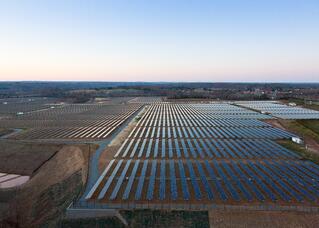Renewable Energy and The Data Center
Regardless, Microsoft recently committed to buy 175 megawatts (MW) of wind energy to power its Chicago data center, Google already has seven contracts for 1,040 MW of wind energy from various locations and Facebook has pledged to eventually hit 100% renewable power.
In an effort to reach 100% renewable power for all its corporate structures and someday take Apple Stores completely off grid, Apple just purchased 100 acres for yet another solar farm project—even though the company’s data centers are already run off 100% renewable energy.
With the big players moving towards renewable energy to power data centers, I thought we would take a closer look at some of the barriers and trends surrounding this practice.
Leveraged Sources
One of the barriers to using on-site wind and solar to power data centers is that locations with the best potential for these sources are not always also the best locations for data centers to reliable serve their users.
Furthermore, data centers operate 24/7 while wind and solar do not. Wind energy is so unpredictable, that at best, it is used typically as a complement for powering a data center rather than a replacement.
Another concern is the initial cost to implement renewable energy and its return on investment. It takes about 7 acres of photovoltaic panels to generate just 1 MW of solar power, and few have the means to take on this type of capital investment. Built specifically for a data center, the largest solar array in Missouri consists of 7,800 square feet (just over a fifth of an acre) with more than 550 panels. However, it only meets 16% of the data center’s power requirements and has a 20-year return on investment.
While the big players have the means (as shown in this picture of Apple’s 20 MW solar farm) and a handful of small data centers have succeeded in providing partial power via on-site solar panels or wind turbines, most are purchasing their renewable power from utilities.
 That is the model that Google deploys for many of its data centers—they buy renewable energy from wind farms that is then incorporated into local power grids. Even if a data center is technically being powered from a non-renewable source, purchasing renewable power from utilities allows owners to offset their carbon footprint by increasing the overall percentage of renewable energy on the grid.
That is the model that Google deploys for many of its data centers—they buy renewable energy from wind farms that is then incorporated into local power grids. Even if a data center is technically being powered from a non-renewable source, purchasing renewable power from utilities allows owners to offset their carbon footprint by increasing the overall percentage of renewable energy on the grid.
Geothermal is also gaining in popularity, both as a cooling system and power source. Used by several Midwest data centers, geothermal cooling systems use the cool temperatures underground to serve as a heat exchanger. Others are taking advantage of Iceland’s cool temperatures and low-cost hydroelectric and geothermal power to support energy-intensive data center operations.
Food for Thought
Regardless of the power source, industry experts agree that the number one goal for data centers is to continue reducing power consumption through the use of a holistic approach that includes energy-efficient design, cooling systems and equipment.
From cranking up the heat closer to ASHRAE’s 80.6?F recommended limit and powering down unused equipment, to using innovative cooling systems and selecting the most energy-efficient designs and equipment, there are many ways that today’s data centers can reduce power consumption. In fact, Google claims that through efficient design, their data centers use only 50% of the energy of most others.
While power usage effectiveness (PUE) doesn’t take into account renewable energy sources, it is still the best metric of energy efficiency in the data center. And Belden’s intelligent PDUs, Environmental Monitors and Sensors and Adaptive Enclosure Heat Containment System go a long way in helping you measure and ultimately achieve data center energy efficiency.
If you’re using renewable energy to power your data center (albeit partially), or if you have any thoughts on this topic, we would love to hear from you. Please leave a comment or schedule a call with one of our data center experts!
![System.String[]](https://assets.belden.com/transform/abe14d20-d3c8-422a-a314-622a95783029/Salvador-Michael?io=transform:fill,width:300,height:300)